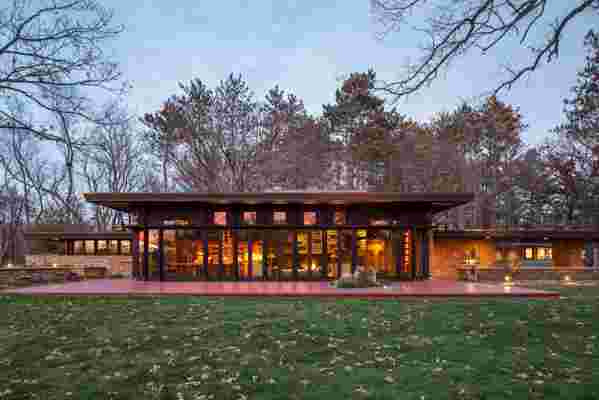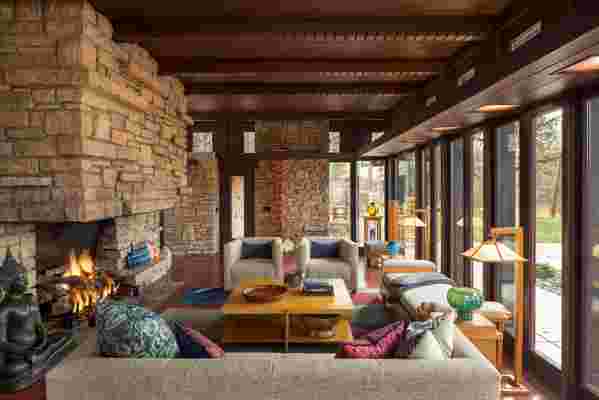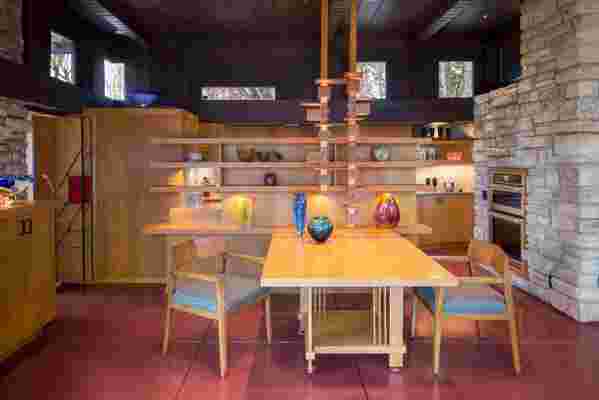When Frank Lloyd Wright names a guest room in his private home after you, you know you’ve made an impression on him. Such was the case with the charismatic Virginia Lovness and her husband, Don. As an artist, Lovness had always dreamed of having her own studio, and when a relative introduced her to the architect in the 1950s, she presented her ideas for the structure to him. Wright, enraptured with Lovness, promptly designed the entire project for her—to his specifications, of course. The result is the Studio that stands on the Lovnesses’ 20-acre lakefront estate in Stillwater, Minnesota, today, which the couple built themselves to Wright’s vision. The architect also sold them plans for another structure, dubbed the Cottage, which was originally designed for another site but ended up being constructed by the Lovnesses in Stillwater. In her later years, Lovness listed her home, but she was reluctant to sell her beloved property, turning down every interested party—until she met Ted and Debi Muntz.

Frank Lloyd Wright designed the Studio, shown here, as well as the second building on the estate.
The native Iowans were introduced to Wright through the Eagle Point Park in their hometown of Dubuque, which featured buildings inspired by the architect’s style. They later incorporated Wrightian elements into a house they built in St. Michael, Minnesota, in 1994. But they weren’t introduced to the Lovness Estate until they came across it in Carla Lind’s book The Wright Style: Re-Creating the Spirit of Frank Lloyd Wright , and when Lovness listed her home in 2007, they knew they wanted it.
“When I asked them how they went about buying the property, Ted said, ‘You mean when I started courting Virginia Lovness?’” recounts interior designer Talla Skogmo, who oversaw the interiors of the renovation. The timing in 2007 wasn’t quite right for the Muntzes, and the house was eventually taken off the market. But several years later, they penned a letter to Lovness, asking if she had sold the home or was still interested in selling it. Ever the hostess, Lovness, who had kept her estate, invited the Muntzes to visit.

The renovated living room.
“The process was a long one—two years or so from my initial letter,” Mr. Muntz tells AD. “It was evident that Virginia, having not found a suitable buyer, had decided to live out her years at the Cottage.” While most potential buyers indicated their desire to relocate the buildings to capitalize on the lakefront property, the Muntzes wanted to preserve the legacy of the estate. “Over time we were able to convince Virginia that we were buyers that would not only preserve the footprint of the property, but would also bring it into the 21st century, which was a necessity for its longevity,” says Mr. Muntz. The couple purchased the estate from Lovness in 2013, under the condition that she could still live in the Cottage.

The dining room.
For the renovation, the Muntzes tapped architect Kelly Davis, then of SALA Architects Inc., a Minnesotan with a personal connection to the Lovness Estate. “It was exactly 50 years ago, as a 16-year-old armed with a new driver’s license, that I drove local back roads looking for the house,” Davis recounts. “When I saw the Wright-designed mailbox, I drove brazenly—and uninvited—up the driveway and was confronted by a foaming-at-the-mouth Doberman Pinscher, whose name I subsequently found out was Lucifer. Virginia Lovness let me suffer for a few minutes before coming out to see what was going on.”
After learning of his interest in the architecture of her home, she gave him the full tour, and the newfound friends continued to cross paths for decades. Though ready to retire when approached by the Muntzes, Davis agreed to sign on to the project. “When Ted and Debi took over stewardship of the property and engaged our help, I decided it would be the perfect last project: a full-circle kind of thing.”
The sitting room.
Though she absolutely cherished the home, Lovness, as she progressed in age, wasn’t able to maintain the Studio. “When we got in there, it was in really tough shape,” says Skogmo. “So pretty much the entire house was taken out, except anything that would still hold the roof up. And the stones!” Starting fresh, Davis was careful to stay as true to Wright’s vision as possible, all the while bringing systems to contemporary standards. “Any time one deals with a landmark Wright design, it becomes a delicate dance in terms of what elements can be tampered with and not affect the overall spirit of the design,” says Davis. “Our goal was always to do our work and make it seamless with the original, so that visitors to the house would not be able to tell it had been modified in any way.”
The kitchen.
Davis did tweak elements of the house, however, to make it a more livable space for the Muntzes, who were clear that this was to be their home and not a museum. For instance, he tweaked the layouts of the kitchen and the baths, which, per Wright’s typical designs, were not the most practical spaces. the architect says. “To maintain some continuity, we did our best to meld the old elements with the new, but if there is one thing I have learned about the Wright community, half will love it (homeowners and some architects) and half will hate it (academics and other architects).”
When Skogmo came in to do the interiors, she faced a bit of a conundrum: The home had been filled with Wright-designed furniture, and while she and the Muntzes wanted to maintain their aesthetic, they also wanted to use pieces that were very comfortable—Wright didn’t necessarily make comfort a priority in his works. Not to mention Mr. Muntz is quite tall, and Wright’s furniture was often designed for a much smaller frame (the architect claimed to be five feet, eight and a half inches tall, though many believe he exaggerated).
A bath.
So Skogmo searched for comfortable but still Wrightesque furniture that would complement the architect’s space, sourcing pieces like the Paris love seat and club chair by Thomas Pheasant for Baker Furniture. She also kept some of the original Wright furniture, like a bench from the Cottage, which she reupholstered to make a bit more comfortable; Wright’s wood light fixtures; and the original dining room table. That table also caused some problems—it was too low for most contemporary chairs. Then when Skogo located the perfect product, a design by by Mark Goetz for Cabot Wrenn, she found out that they were specifically designed for the Pratt Institute in New York and weren’t available for purchase. Luckily, she was able to negotiate and acquire a set of the chairs for the Studio, which is now the only place you can find them outside the university.
The renovation was completed last year, and the Muntzes are, of course, thrilled with their home. “We have a relaxing and calming lifestyle where we sleep to the sound of coyotes and wake up to the sound of loons. Wildlife looks in on us as much as we look out at them.” says Mrs. Muntz. Her husband agrees. “It is living in nature, but framed by the lines in the architecture,” he says.
And while it’s lovely that the new homeowners are enjoying the Studio, the success of the renovation was made a little sweeter by the approval of Virginia Lovness, who was able to witness the project from start to finish before she passed away in February this year.
Ted and Debi Muntz with Virginia Lovness.
“The last time I saw Virginia was the day the final photos of the project were taken in November 2017,” says Davis. “She was pleased by what she saw, pleased by what Ted and Debi had accomplished in giving the home new life; and, at 92, glass of Champagne in hand, she once again, and in her inimitable and delightful way, completely took over the room she and Don had built.”
RELATED: 10 Frank Lloyd Wright–Designed Houses You Can Stay In
